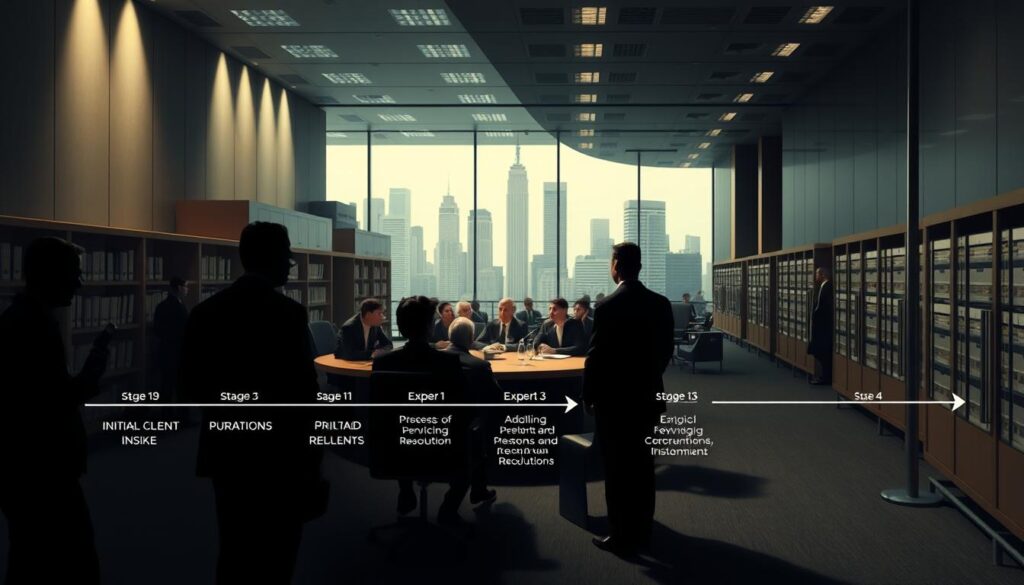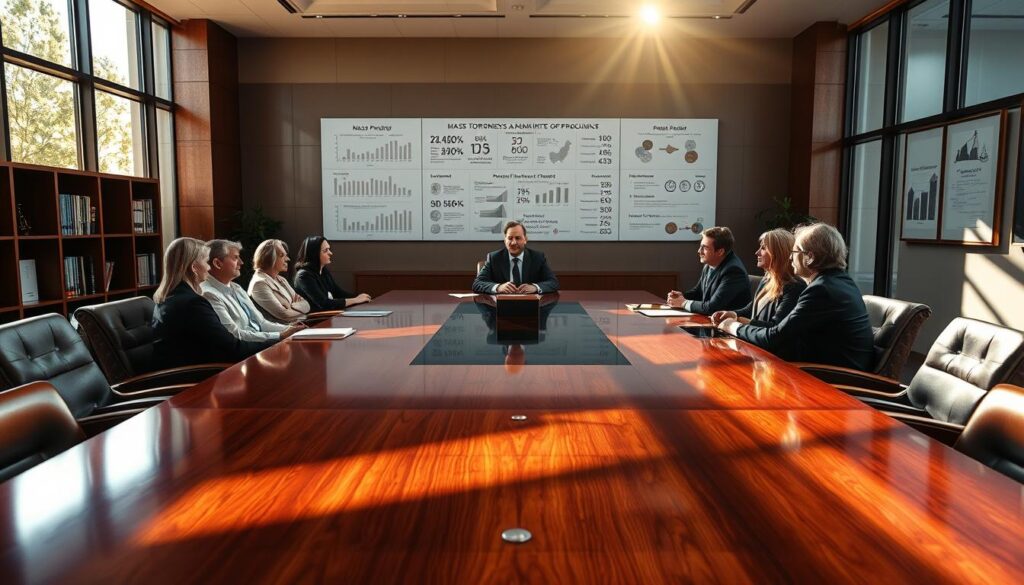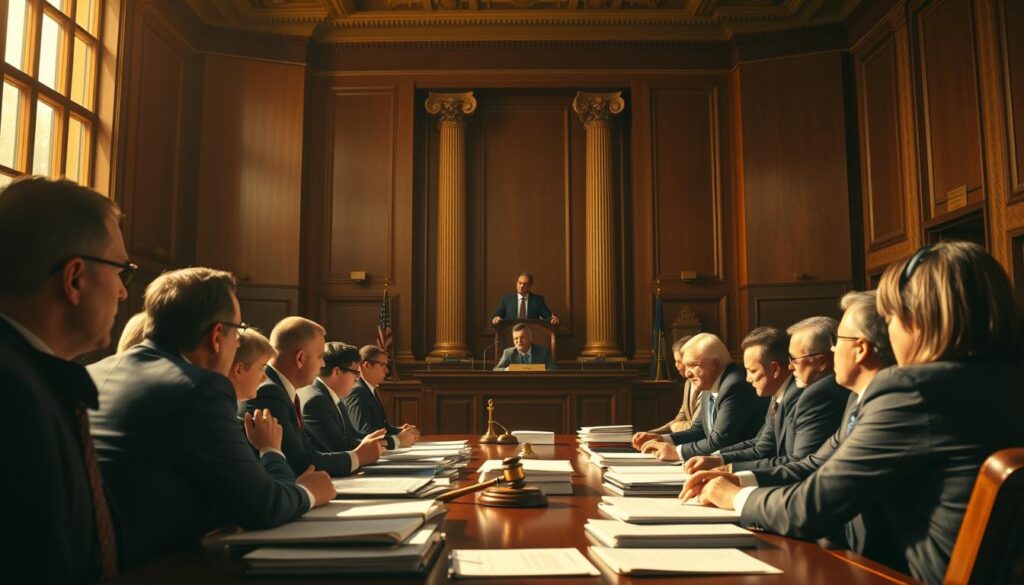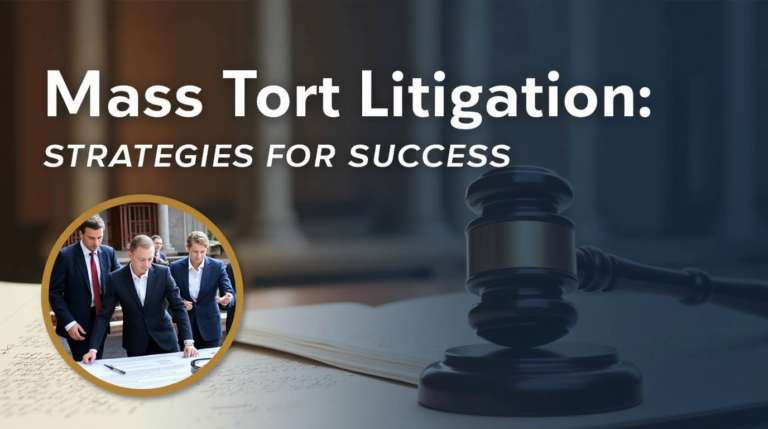Mass tort litigation is a strong legal tool for dealing with widespread harm. It turns individual suffering into a united effort for justice. Imagine many lives affected by one mistake—this is what mass tort litigation is all about.
Through mass tort litigation, people can stand together against big entities. It lets many plaintiffs fight for justice at once. This way, they can tackle big problems that might otherwise be ignored.
Mass tort litigation is more than just getting money back. It’s a way to make sure companies are held responsible. It keeps us safe and makes sure those who were hurt get fair compensation. Your case can help change things for the better.
Table of Contents
Understanding Mass Tort Litigation Fundamentals

Mass tort litigation is a strong legal tool for dealing with widespread harm. This includes issues with defective products, dangerous drugs, or corporate mistakes. It’s different from regular lawsuits because it lets many plaintiffs fight against one defendant together.
Differences Between Mass Torts and Class Actions
Mass tort litigation stands out from class action lawsuits in several ways:
- It treats each case individually, not as a group
- Assesses damages for each plaintiff separately
- Offers a more tailored legal approach
- Compensation varies based on the harm each person suffered
Key Components of Mass Tort Cases
Mass tort cases often involve many people getting hurt in the same way. For instance, the 3M earplug case is a good example. The company had to pay $10.3 billion to settle claims about faulty earplugs for soldiers.
Important parts of mass tort cases include:
- Finding a common cause of injury
- Showing the defendant was at fault
- Recording each plaintiff’s damages
- Building evidence of the harm
Legal Framework and Jurisdiction
Multidistrict litigation (MDL) is key in handling big mass tort cases. It lets courts group similar cases together. This makes the legal process smoother while still allowing for unique settlements for each plaintiff.
Multidistrict litigation makes complex legal cases easier to manage. It helps reduce the burden on courts and ensures a consistent legal approach.
Understanding these legal strategies can greatly affect your chances in lawsuits against companies or manufacturers that have been negligent.
The Life Cycle of Mass Tort Cases

Mass tort cases are a long and complex legal journey. They can last for years and involve thousands of people seeking justice. It’s important for legal experts to know the life cycle of these cases, especially in product liability and toxic exposure cases.
The life cycle of mass tort cases goes through three main stages:
- Early Stage: Initial Case Development
- High-risk period with lower acquisition costs
- Initial case investigations and plaintiff screening
- Gathering preliminary evidence for potential claims
- Mid-Stage: Litigation Strategy Solidification
- Potential Multidistrict Litigation (MDL) establishment
- Bellwether trials to test case strengths
- Strategic consolidation of similar claims
- Late Stage: Settlement and Resolution
- Lower litigation risks
- Higher potential for substantial compensation
- Negotiation and potential global settlement
To succeed in these stages, you need a solid strategy and a deep understanding of the legal world.
| Stage | Key Characteristics | Risk Level |
|---|---|---|
| Early Stage | Initial case development | High |
| Mid-Stage | Litigation strategy formation | Moderate |
| Late Stage | Settlement negotiations | Low |
Most mass tort cases end in a settlement. The amount of compensation depends on the individual’s damages. The chance of a bigger settlement grows with strong evidence and more claims.
Understanding the mass tort life cycle helps legal experts make better decisions about getting involved and what to expect.
Essential Elements for Case Evaluation
When dealing with defective products or pharmaceutical cases, lawyers must carefully look at several key factors. These help decide if a case is strong and likely to win.

Your case evaluation has three main parts. These parts are crucial for a mass tort lawsuit’s success:
Assessing Injury Severity and Causation
Checking the injury is key in mass tort cases. You need to:
- Document the extent of physical harm
- Analyze long-term medical effects
- See if the injury is linked to the product
- Have all medical records
Analyzing Evidence Strength
The strength of evidence is vital in pharmaceutical cases. Important things to look at include:
- Scientific studies that show causation
- Expert medical opinions
- Proof of product defects
- Similar injuries in others
Determining Financial Viability
Money matters a lot in mass tort cases. You should look at:
| Financial Factor | Assessment Criteria |
|---|---|
| Potential Damages | Estimated compensation range |
| Litigation Costs | Anticipated legal expenses |
| Defendant’s Resources | Ability to pay settlements |
By carefully checking these key points, you can make smart choices about pursuing a mass tort case. This helps ensure fair compensation for those affected.
Building a Strong Plaintiff Pool

Creating a strong plaintiff pool is key in personal injury and medical device cases. Success relies on smart recruitment and detailed screening. These steps help find people with real claims.
To build a plaintiff pool, focus on several strategies:
- Do thorough initial screenings
- Run targeted ad campaigns
- Work with medical professionals
- Use digital marketing
- Keep communication clear
Recruiting plaintiffs well needs a mix of methods. Medical device cases need careful finding of those harmed. Your checks should look at:
- Medical records
- How bad the injury is
- If the device caused the harm
- When the harm happened
Digital tools are great for finding potential plaintiffs. Social media, legal sites, and ads can reach those with valid claims.
A strong plaintiff pool boosts your bargaining power. It shows the wide reach of possible corporate mistakes.
Always keep ethics in mind. Your approach must focus on real victims’ stories. Keep your legal actions professional and honest.
Strategic Approaches to Multidistrict Litigation
Multidistrict litigation (MDL) is a strong legal strategy for dealing with big legal issues. It’s especially useful in cases of environmental disasters. When many similar lawsuits pop up in different places, MDL helps by combining them into one process.

The MDL process lets federal courts handle big cases better by focusing on one place for early steps. This makes things more efficient and helps avoid doing the same work over and over. It also makes sure judges make the same kinds of decisions.
MDL Formation Process
To understand how MDL works, you need to know a few important steps:
- Identifying cases with common legal questions
- Requesting consolidation through the Judicial Panel on Multidistrict Litigation (JPML)
- Selecting a single federal court for pretrial proceedings
- Appointing leadership counsel for plaintiffs and defendants
Coordinating with Multiple Jurisdictions
Managing MDL well means working well with different legal areas. Your team needs to have good communication and be ready to adapt to different needs.
Strategic planning in MDL can save millions in legal expenses and streamline complex litigation processes.
Here are some key ways to coordinate:
- Establishing clear communication channels
- Developing consistent pretrial discovery protocols
- Selecting representative bellwether trials
- Creating standardized documentation processes
By using MDL strategies, legal teams can handle big cases well. They keep the process efficient and cut down on legal costs.
Managing Case Documentation and Evidence
Managing documents in mass tort litigation is crucial. The large amount of evidence in product liability cases can be overwhelming. This is why having a strong organizational plan is key.
“Effective documentation is the backbone of successful mass tort litigation” – Legal Research Institute
Here are some important strategies for managing case documents:
- Implement centralized digital document management systems
- Ensure strict chain of custody for physical evidence
- Utilize advanced e-discovery technologies
- Maintain comprehensive digital record platforms
Modern mass tort litigation needs advanced technology. Cloud-based platforms help with document retrieval, cut costs, and improve teamwork among law firms.
| Document Management Feature | Litigation Benefit |
|---|---|
| Automated Deadline Tracking | Ensures Critical Filing Compliance |
| Integrated Analytics Tools | Monitors Case Outcomes |
| Secure Client Communication Portals | Improves Client Engagement |
By using the latest document management technologies, your team can handle the complex needs of mass tort litigation. This will help strengthen your case strategy.
Expert Witness Selection and Testimony
Choosing the right expert witness is key in pharmaceutical and medical device litigation. They must turn complex science into clear courtroom evidence. This is crucial for your case’s success.
Expert witnesses are vital in mass tort cases. They offer insights that can change your legal strategy. Their role is to connect scientific knowledge with what the court can understand.
Medical Expert Requirements
Finding the right expert is not easy. Look for these important qualities:
- Advanced medical credentials and specialized expertise
- Proven track record in courtroom testimony
- Strong reputation in their professional field
- Ability to communicate complex information clearly
Scientific Evidence Presentation
It’s important to present scientific evidence well in pharmaceutical cases. Your expert should make technical data easy for judges and juries to understand.
Expert witnesses are increasingly engaged in early case stages, significantly enhancing case credibility and potential outcomes.
To make your expert’s impact stronger, focus on:
- Clear, jargon-free explanations
- Visual aids and demonstrative evidence
- Consistent professional background
- Thorough preparation for potential challenges
With the right selection and preparation, expert witnesses can be powerful allies. They can make complex science into strong legal arguments.
Risk Assessment in Mass Tort Litigation
Handling toxic exposure cases needs a careful plan for managing risks. Your legal team must look at many aspects of environmental disaster lawsuits. This helps avoid big financial and legal problems.
Important steps in risk assessment include:
- Looking at the strength of scientific evidence
- Checking if the defendant can pay
- Watching for any new laws or rules
- Figuring out how much resources will be needed
Law firms like Hunton and Sidley use smart ways to reduce risks. They spread out their cases and work with partners in different places. Handling big toxic tort cases needs a lot of preparation and the right experts.
Your plan should include:
- Having all the scientific facts ready
- Picking the right experts
- Keeping an eye on costs
- Offering flexible prices for legal services
Important things in toxic exposure cases are knowing about diseases that take a long time to show up. Also, figuring out which chemicals are involved. With a good risk assessment plan, your team can tackle the challenges of environmental disaster lawsuits.
Success in mass tort litigation demands comprehensive risk evaluation and adaptive strategic planning.
Settlement Negotiation Strategies
Settlement negotiations in personal injury claims need smart planning and strategy. Your approach can greatly affect the outcome of class action lawsuits. This can mean big wins for hundreds or thousands of people.
Good settlement talks can cut legal costs by up to 90% compared to trial. About 95% of civil cases settle out of court. So, negotiation skills are key for lawyers in mass tort cases.
Evaluating Settlement Offers
When looking at settlement offers, consider these important points:
- Strength of evidence
- Potential jury awards
- Defendant’s financial capacity
- Scope of damages across plaintiff pool
- Long-term impact of injuries
Distribution Mechanisms
Getting settlement funds to the right people needs a clear plan. Legal teams use detailed matrices for this. They look at:
- Injury severity
- Documented medical expenses
- Long-term treatment needs
- How each plaintiff is affected
Lawyers who set realistic goals during negotiations are 25% more likely to get a good settlement for their clients.
Winning class action lawsuits needs careful planning, clear talks, and a deep understanding of the law. Your negotiation strategy can lead to big wins or small settlements.
Technology and Mass Tort Management
Technology has changed how lawyers handle big cases. New tools help track, analyze, and make processes smoother in complex lawsuits.
Some key tech advancements include:
- Advanced case management platforms
- AI-powered document review systems
- Secure cloud-based collaboration tools
- Real-time communication technologies
Now, software helps legal teams deal with huge amounts of documents. Tools like LMI DataLens™ and LMI Exchange™ manage medical records and share documents safely for mass tort cases.
“Technology is no longer optional in mass tort litigation—it’s essential for competitive legal practice.”
Artificial intelligence and machine learning have made reviewing documents faster. They can go through millions of documents quickly, cutting down on mistakes and speeding up case prep.
Keeping data safe is also crucial. Legal teams need to use platforms with strong security to protect client info during lawsuits.
- Secure cloud storage
- Encrypted communication channels
- Multi-factor authentication
- Comprehensive access controls
Law firms can improve their work by using these new technologies. They can work more efficiently, accurately, and communicate better with clients in mass tort cases.
Financial Planning for Mass Tort Cases
Handling the money side of mass tort cases needs smart planning and careful handling. Personal injury claims and lawsuits over drugs require strong financial plans to face big legal battles.
Your law firm must create detailed financial plans to deal with the big costs of mass tort cases. These cases can last for years, needing a lot of resources.
Budgeting for Litigation Expenses
Good financial management in mass tort cases means looking at several key points:
- Figuring out what expert witnesses will cost
- Handling the cost of reviewing and keeping documents
- Coming up with plans to find plaintiffs
- Setting aside money for scientific studies
Managing Client Expectations
Telling clients clearly about costs and how long things will take is key in drug lawsuits. Clients must understand the financial commitment of going after mass tort claims.
| Expense Category | Estimated Cost Range | Funding Options |
|---|---|---|
| Expert Witness Fees | $5,000 – $50,000 | Contingency Arrangements |
| Document Management | $10,000 – $100,000 | Litigation Funding |
| Plaintiff Advertising | $25,000 – $250,000 | Firm Partnerships |
Knowing about financing options like litigation funding, loans, and partnerships can help your firm handle the money side of mass tort cases well.
Common Types of Mass Tort Claims
Mass tort litigation involves many cases where many people get hurt by bad products or toxic stuff. Knowing about these types helps you understand the legal world better and protect your rights.
Pharmaceutical and medical device lawsuits are big in mass tort claims. These cases happen when drugs or devices are harmful. For example, bad hip implants or pacemakers can hurt thousands of people.
- Pharmaceutical Mass Torts
- Medical Device Litigation
- Environmental Exposure Claims
- Consumer Product Defects
Environmental toxic exposure cases are also very important in mass tort lawsuits. The Camp Lejeune case shows how chemicals can harm many people over time, leading to serious health issues.
| Mass Tort Type | Average Settlement Range | Typical Duration |
|---|---|---|
| Pharmaceutical Claims | $100,000 – $250,000 | 3-10 years |
| Medical Device Litigation | $100,000 – $500,000 | 2-7 years |
| Environmental Toxic Exposure | $50,000 – $1 million | 4-12 years |
“Mass tort claims provide a critical legal pathway for victims to seek justice and compensation for widespread harm caused by negligent corporations.”
Consumer product defects are another big area in mass tort claims. These happen when products are faulty and cause harm to many people. Examples include bad airbags or dangerous household items that hurt many across different places.
Conclusion
Mass tort litigation is a strong way for people to seek justice in personal injury cases. Knowing how these legal processes work can help a lot. It helps hold big companies accountable for harm done to many.
Winning in mass tort litigation needs careful planning and strong legal help. Firms like PMR Law show how important it is to have the right knowledge. They help people get fair compensation, but it takes a lot of work and smart legal moves.
The legal world is always changing, and keeping up is crucial. The 3M earplug settlement, worth US$6.01 billion, shows how big of an impact these cases can have. Working with skilled lawyers and staying informed can help you fight for justice in tough cases.
The future of mass tort litigation looks bright, with more chances for group legal actions. Your effort to learn about these complex legal matters is vital. It helps you get fair compensation and makes sure those who did wrong are held accountable.


1 thought on “Mass Tort Litigation: Strategies for Success”